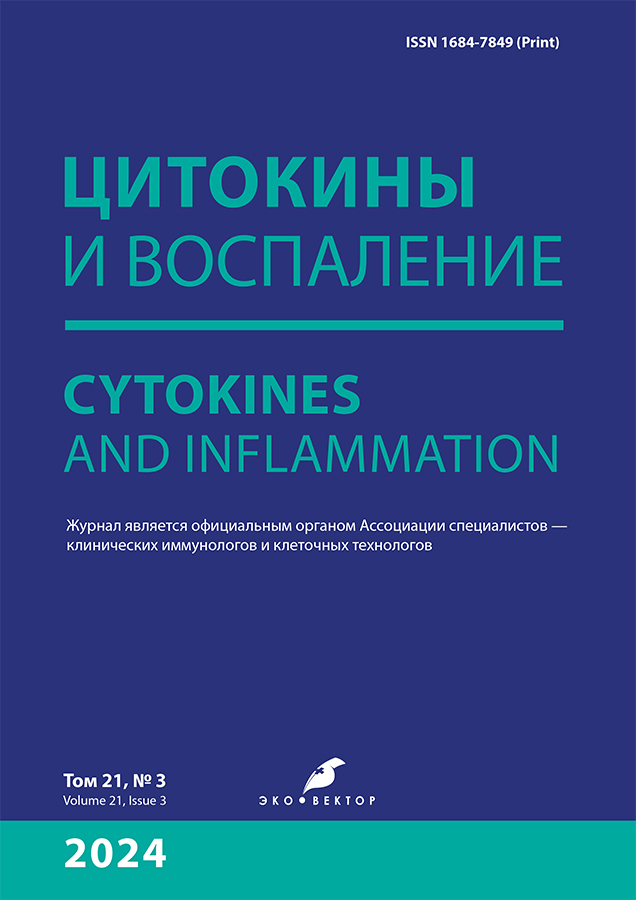Changes in Cytokine Profile in Patients with Different Phenotypes of Chronic Rhinosinusitis
- Authors: Smirnova O.V.1,2, Sinyakov A.A.1
-
Affiliations:
- Krasnoyarsk Science Centre of the Siberian Branch of the Russian Academy of Sciences
- Siberian Federal University
- Issue: Vol 21, No 3 (2024)
- Pages: 162-168
- Section: Original Study Articles
- URL: https://cijournal.ru/1684-7849/article/view/637071
- DOI: https://doi.org/10.17816/CI637071
- EDN: https://elibrary.ru/QGJZQR
- ID: 637071
Cite item
Abstract
BACKGROUND: In Russia, approximately 1,500,000 individuals are affected by chronic rhinosinusitis, whereas in the United States, the number reaches 30–35 million people, or 4.9 per 10,000 population. Despite numerous studies investigating the role of chronic inflammation of the nasal and paranasal sinus mucosa, as well as allergic mechanisms in the pathogenesis of chronic rhinosinusitis, the significance of various cytokines in disease development has not been fully established.
AIM: To investigate cytokine regulation in patients with chronic rhinosinusitis depending on disease phenotype.
MATERIALS AND METHODS: A total of 61 patients with chronic rhinosinusitis were enrolled. The control group included 30 practically healthy blood donors. Cytokine levels were measured in serum using enzyme immunoassay. Statistical analysis was performed using Statistica 10 software.
RESULTS: Analysis of selected cytokines in patients with different phenotypes of chronic rhinosinusitis revealed diverse changes in the cytokine profile.
CONCLUSION: Patients with chronic polypous rhinosinusitis exhibited a Th1-type immune response; those with chronic hyperplastic rhinosinusitis, a Th1/Th17-type response; those with chronic allergic rhinosinusitis, a Th2-type response; and those with chronic infectious rhinosinusitis, a Th17-type response.
Full Text
About the authors
Olga V. Smirnova
Krasnoyarsk Science Centre of the Siberian Branch of the Russian Academy of Sciences; Siberian Federal University
Author for correspondence.
Email: ovsmirnova71@mail.ru
ORCID iD: 0000-0003-3992-9207
SPIN-code: 2198-0265
MD, Dr. Sci. (Medicine), Professor
Russian Federation, Krasnoyarsk; KrasnoyarskAlexander A. Sinyakov
Krasnoyarsk Science Centre of the Siberian Branch of the Russian Academy of Sciences
Email: sinyakov.alekzandr@mail.ru
ORCID iD: 0000-0002-4474-1893
SPIN-code: 8600-0003
Cand. Sci. (Biology)
Russian Federation, KrasnoyarskReferences
- Piskunov GZ, Moiseeva YuP. Polypous rhinosinusitis. 2nd ed., add. Moscow: MEDpress-inform; 2021. 136 p. (In Russ.) ISBN: 978-5-00030-891-2
- Fokkens WJ, Lund VJ, Hopkins C, et al. European position paper on rhinosinusitis and nasal polyps 2020. Rhinology. 2020;58(Suppl S29):1–464. doi: 10.4193/Rhin20.600 EDN: THMJZZ
- Piskunov GZ. Clinical phenotypes of polyposis rhinosinusitis. Russian Rhinology. 2019;27(4):224–231. doi: 10.17116/rosrino201927041224 EDN: EPGXQF
- Lam K, Schleimer R, Kern RC. The etiology and pathogenesis of chronic rhinosinusitis: a review of current hypotheses. Curr Allergy Asthma Rep. 2015;15(7):41. doi: 10.1007/s11882-015-0540-2 EDN: FTKTOI
- Simbirtsev AS. Cytokines and their role in immune pathogenesis of allergy. Russian Medical Inquiry. 2021;5(1):32–37. doi: 10.32364/2587-6821-2021-5-1-32-37 EDN: BGPEMG
- Kokorina OV, Boeva VI, Apalko SV, et al. Cytokine profile of chronic rhinosinusitis without polyps. Russian Bulletin of Otorhinolaryngology. 2022;87(4):51–55. doi: 10.17116/otorino20228704151 EDN: KNVQAP
- Manikovskaya TM. Studying the role of some cytokines in the formation of chronic polyposis rhinosinusitis, review of the literature. In: Actual problems of pathophysiology. Collection of scientific articles of the International scientific and practical conference. Lareva NV, editor. Chita: Chita State Medical Academy; 2022. P. 101–104. EDN: QWIXJO
- Piskunov GZ, Arefieva NA, Karpishchenko SA, et al. Clinical guidelines. Polypous rhinosinusitis. Russian society of rhinologists. 2022–2025. Moscow; 2022. 54 p. (In Russ.) URL: http://rhinology.ru/wp-content/uploads/2022/10/ПРС-Клинические_рекомендации_финал.pdf
- Tereshchenko IV, Kayushev PE. Tumor necrosis factor α and its role in pathologies. Russian Medical Inquiry. 2022;6(9):523–527. doi: 10.32364/2587-6821-2022-6-9-523-527 EDN: CMHVKK
- Schoenborn JR, Wilson CB. Regulation of interferon-γ during innate and adaptive immune responses. Adv Immunol. 2007;96:41–101. doi: 10.1016/S0065-2776(07)96002-2
- von Loeffelholz C, Lieske S, Neuschäfer-Rube F, et al. The human longevity gene homolog INDY and interleukin-6 interact in hepatic lipid metabolism. Hepatology. 2017;66(2):616–630. doi: 10.1002/hep.29089
- Rogina B. INDY-A new link to metabolic regulation in animals and humans. Front genet. 2017;8:66. doi: 10.3389/fgene.2017.00066
- Kuestner RE, Taft DW, Haran A, et al. Identification of the IL-17 receptor related molecule IL-17RC as the receptor for IL-17F. J Immunol. 2007;179(8):5462–5473. doi: 10.4049/jimmunol.179.8.5462.PMC2849293
- Said EA, Dupuy FP, Trautmann L, et al. Programmed death-1-induced interleukin-10 production by monocytes impairs CD4+ T cell activation during HIV infection. Nat Med. 2010;16(4):452–459. doi: 10.1038/nm.2106 EDN: MPMYIK
Supplementary files









